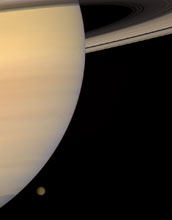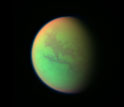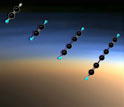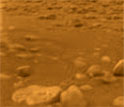News Release 09-172
Unraveling the Chemistry of Titan's Hazy Atmosphere
Research study provides information about how a key molecule in Titan's atmosphere may be formed and offers clues to the evolution of Titan's and Earth's atmospheres

A view of Saturn and Titan created by combining images taken by the Cassini spacecraft January 2008.
September 15, 2009
This material is available primarily for archival purposes. Telephone numbers or other contact information may be out of date; please see current contact information at media contacts.
An international team of scientists has announced the confirmation of a key chemical reaction that forms the molecule triacetylene in the ultra-cold atmosphere of Saturn's moon Titan.
Since Titan's current atmosphere is thought to resemble Earth's early atmosphere, the researchers' study suggests triacetylene may have been formed in Earth's early atmosphere and offers clues to the evolution of Earth's atmosphere before the development of life some 3.5 billion years ago.
The team presents their findings in the Sept. 14, 2009, advance online issue of the Proceedings of the National Academy of Sciences. Funding for the study was provided by the National Science Foundation (NSF).
Triacetylene is member of the polyyne family of compounds. Polyynes are thought to serve as an ultraviolet radiation shield in planetary environments, thus acting as prebiotic ozone, and as important components of the orange-colored and aerosol-based haze shrouding Titan.
Scientists have been researching the role of triacetylene, as well as the polyyne diacetylene, in the chemical evolution of Titan's atmosphere for the last four decades.
Triacetylene and diacetylene are molecules consisting of six and four carbon atoms, respectively, and two hydrogen atoms. The atoms in each molecule are connected by alternating single and triple bonds.
Alas, the underlying chemical processes initiating and controlling the formation and growth of the two polyynes are the least understood to date.
Based on limited laboratory studies related to the formation of soot, early planetary chemists developed photochemical models of Titan's atmosphere.
"Surprisingly, the photochemical models show inconsistent mechanisms for the production of polyynes," said Ralf Kaiser, a physical chemist at the University of Hawaii, co-author and team leader. A mechanism is the sequence of steps in a chemical reaction.
The arrival of the Cassini spacecraft at Titan in 2004, and the landing of its Huygens probe on Titan's surface in 2005, confirmed the abundance of diacetylene and acetylene on Titan. Acetylene is made of two carbon and two hydrogen atoms; the carbon atoms are connected by a triple bond. Triacetylene was also detected in Titan's most outer atmosphere via a positively charged form of triacetylene with an additional hydrogen atom.
The mission also revealed that the transformation of acetylene and diacetylene to polyacetylenes such as triacetylene likely present one of the most fundamental steps in the evolution of planetary atmospheres.
To unravel the formation of triacetylene and provide an accurate photochemical model, Kaiser and his collaborators first confirmed in their earthly laboratory that triacetylene can be formed by a single collision of a "radical" ethynyl molecule and a diacetylene molecule.
Ethynyl is highly reactive and made of two carbon atoms connected by a triple bond, one hydrogen atom connected by a single bond, and a lone electron on the exterior carbon atom. It is the lone or radical electron that initiates ethynyl's attack on other molecules (see third side image).
Ethynyl is produced in Titan's atmosphere by the photodissociation of acetylene by ultraviolet light. Photodissociation is a chemical reaction that uses light's photons to break down a chemical compound.
To conduct the experiment, Kaiser's group used a "crossed molecular beam" machine to collide supersonic gaseous beams of ethynyl and diacetylene molecules. Angular resolved mass spectrometer measurements of the reaction products confirmed that triacetylene, plus a single hydrogen atom, were produced.
To reveal the mechanism involved in the formation of triacetylene, Alexander Mebel, a theoretical chemist at Florida International University, merged the experimental results with theoretical computations of the reaction of ethynyl and diacetylene. Theoretical computations also provide the 3-D distribution of electrons in atoms and thus the overall energy level of a molecule.
Mebel's computations confirmed that triacetylene may be formed from the reaction of a single radical ethynyl molecule colliding with diacetylene and the existence of three transient intermediate molecules.
Perhaps most importantly, since the temperature of Titan's atmosphere ranges from -99 F, or -73 C, to -290 F, or -179 C, which necessitates the need for chemical reactions to release energy, Mebel's computations confirmed that the formation of triacetylene releases energy.
To complete their study, Danie Liang and Yuk Yung, planetary scientists at Taiwan's Academia Sinica and California Institute of Technology (Caltech), respectively, performed photochemical modeling studies of Titan's atmosphere. The models suggest that triacetylene may serve as a building block to form more complex and longer polyynes and produce potential precursors for the aerosol-based layers of haze surrounding Titan.
Using a combined experimental, theoretical and modeling study, "Kaiser and his collaborators have demonstrated a successful approach to solving a complex chemistry problem," said Charles Pibel, a program director in the NSF Division of Chemistry.
In the future, Kaiser will combine his research results with terrestrial-based observations of Titan's atmosphere. Alan Tokunaga, an astronomer at the University of Hawaii, Institute for Astronomy, is currently collecting these observations using an infrared telescope situated on the snowcapped peak of Mauna Kea, an inactive volcano in Hawaii.
Co-authors of the paper include Xibin Gu and Seol Kim, University of Hawaii; Alexander Mebel, Florida International University; Danie Liang, Academia Sinica; and Yuk L. Yung, Caltech.
Funding for the study is provided by the NSF Division of Chemistry and Office of International Science and Engineering (Gu, Kim, Kaiser, Mebel), and the National Science Council, Taiwan (Liang).
-NSF-
-
Three views of Titan: a natural color composite, monochrome view and false-color composite.
Credit and Larger Version -
An ultraviolet night-side view of Titan's upper atmosphere and its many fine layers of haze.
Credit and Larger Version -
Left to right: images of a radical ethynyl, acetylene, diacetylene and triacetylene molecule.
Credit and Larger Version -
An artist's concept showing the European Space Agency's Huygens probe descent to Titan's surface.
Credit and Larger Version -
Image of rock-like objects taken by the Huygens probe during its descent to Titan's surface.
Credit and Larger Version
Media Contacts
Jennifer A. Grasswick, NSF, (703) 292-4972, email: jgrasswi@nsf.gov
Joshua A. Chamot, NSF, (703) 292-7730, email: jchamot@nsf.gov
Program Contacts
Charles D. Pibel, NSF, (703) 292-4971, email: cpibel@nsf.gov
Principal Investigators
Ralf I. Kaiser, University of Hawai’i at Manoa, (808) 956-5731, email: ralfk@hawaii.edu
Related Websites
NSF Division of Chemistry Award Abstract: http://www.nsf.gov/awardsearch/showAward.do?AwardNumber=0627854
Ralf I. Kaiser: http://manoa.hawaii.edu/chem/index.php?id=50
Solar System Exploration: Saturn: Moons: http://solarsystem.nasa.gov/planets/profile.cfm?Object=Saturn&Display=Moons
Photojournal: Images of Titan:: http://photojournal.jpl.nasa.gov/target/Titan
Solar System Exploration: Cassini-Huygens:: http://solarsystem.nasa.gov/missions/cassini
Cassini Equinox Mission: About Saturn and Its Moons:: http://saturn.jpl.nasa.gov/science/index.cfm?SciencePageID=73
The U.S. National Science Foundation propels the nation forward by advancing fundamental research in all fields of science and engineering. NSF supports research and people by providing facilities, instruments and funding to support their ingenuity and sustain the U.S. as a global leader in research and innovation. With a fiscal year 2023 budget of $9.5 billion, NSF funds reach all 50 states through grants to nearly 2,000 colleges, universities and institutions. Each year, NSF receives more than 40,000 competitive proposals and makes about 11,000 new awards. Those awards include support for cooperative research with industry, Arctic and Antarctic research and operations, and U.S. participation in international scientific efforts.
Connect with us online
NSF website: nsf.gov
NSF News: nsf.gov/news
For News Media: nsf.gov/news/newsroom
Statistics: nsf.gov/statistics/
Awards database: nsf.gov/awardsearch/
Follow us on social
Twitter: twitter.com/NSF
Facebook: facebook.com/US.NSF
Instagram: instagram.com/nsfgov





